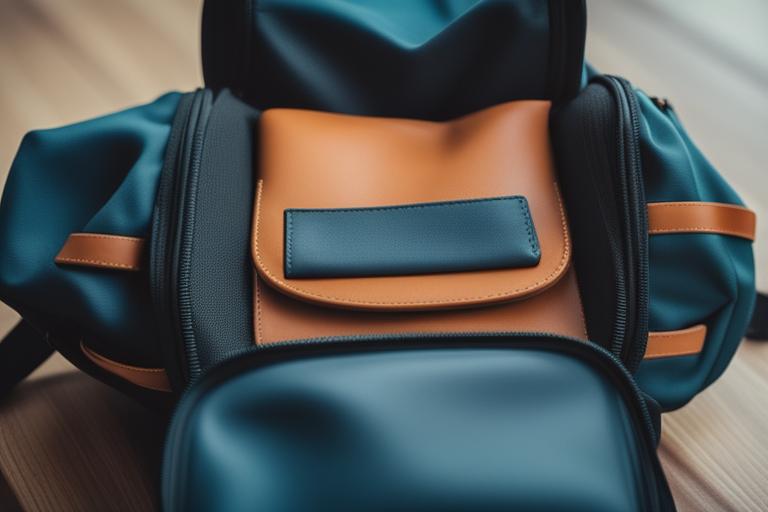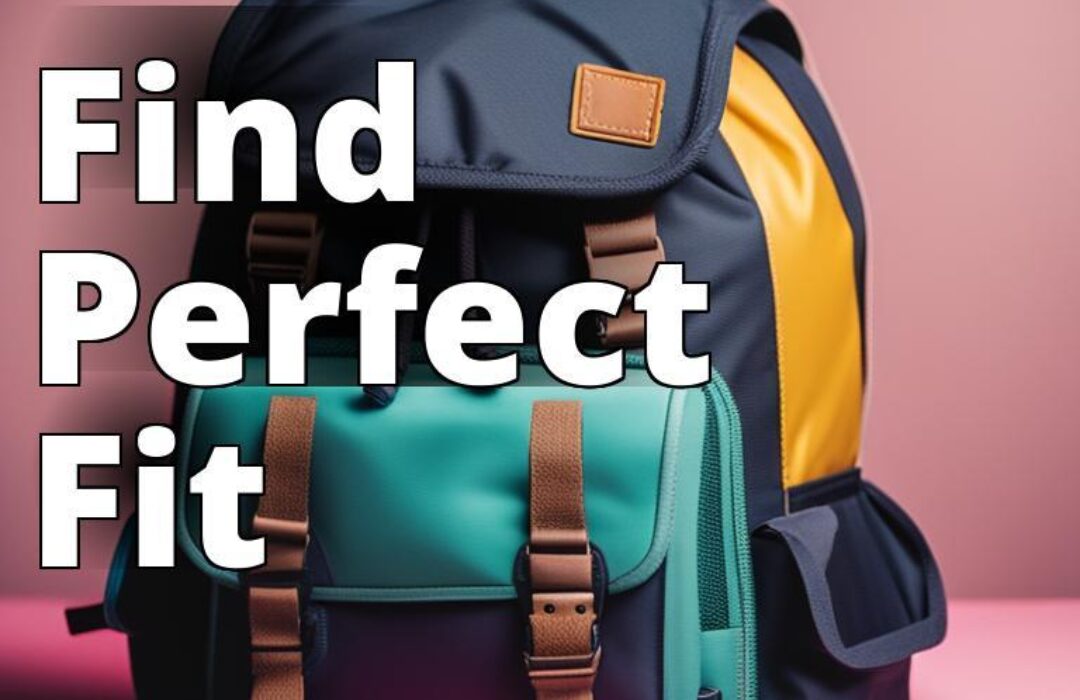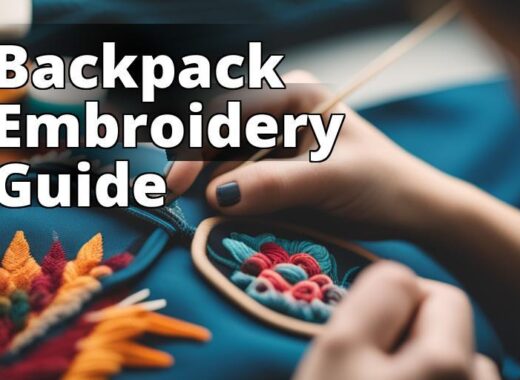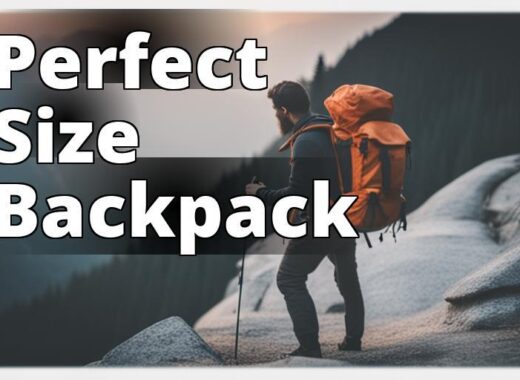When it comes to selecting a backpack for your kindergartener, one question that often arises is: what size backpack is good for kindergarten? The size of the backpack is a crucial factor to consider as it directly affects your child’s comfort, safety, and overall well-being. In this article, we will explore the importance of choosing the appropriate backpack size for kindergarteners and provide valuable insights to help you make an informed decision.
What size backpack is good for kindergarten?
- The article explains the importance of choosing the right backpack size for kindergarteners.
- It suggests assessing the specific requirements and recommendations of the child’s kindergarten program.
- The article provides factors to consider, such as determining the purpose of the backpack, measuring the child’s body, considering weight distribution and support, assessing capacity and compartments, trying on different sizes, and considering durability and quality.

Understanding the Importance of Choosing the Right Backpack Size
Before delving into the factors to consider when choosing a backpack size, it’s essential to understand why this decision matters. Kindergarteners have developing bodies that are more susceptible to strain and injury. Carrying a backpack that is not the right size can lead to discomfort, back pain, and even postural issues. Prioritizing your child’s physical well-being by ensuring they have a backpack that properly fits their needs is of utmost importance.

Assessing Kindergarten Program Requirements
Every kindergarten program may have specific requirements and expectations when it comes to backpack sizes. Some schools provide guidelines or recommendations for parents to follow. Familiarizing yourself with these requirements will ensure that your child’s backpack meets the necessary criteria. By doing so, you can avoid potential issues or conflicts with the school and ensure that your child is well-prepared for their daily activities.

Factors to Consider When Choosing a Backpack Size
Now that we understand the importance of choosing the right backpack size, let’s explore the key factors to consider during the selection process.

A. Determining the Purpose of the Backpack
First and foremost, consider the purpose of the backpack. Identify the items your child needs to carry on a daily basis, such as books, lunch boxes, school supplies, and even additional items for after-school activities. Understanding their specific needs will help you determine the appropriate backpack size.
B. Measuring Your Child’s Body
Measuring your child’s body is an essential step in finding the right backpack size. Start by measuring their height and weight as a general indication of their body size. Then, measure their torso length, which is the distance between the base of the neck and the top of the hip bone. This measurement will help you determine the ideal backpack size that will provide proper support and weight distribution.
C. Weight Distribution and Support
Even weight distribution is crucial to prevent strain on your child’s back and shoulders. Look for backpacks with wide, padded shoulder straps. These straps help distribute the weight evenly and reduce the pressure on specific areas. Additionally, consider a backpack with a waist strap. The waist strap adds extra support and helps stabilize the load, reducing the strain on the back.
D. Capacity and Compartments
The capacity of the backpack is another crucial factor to consider. Assess the items your child needs to carry and choose a backpack with an appropriate capacity. It should be spacious enough to accommodate their essentials without being too bulky or heavy. Additionally, consider the number and size of compartments needed for organization. Compartments can help keep items separate and easily accessible, promoting efficiency and convenience.

E. Trying on Different Backpack Sizes
While online shopping offers convenience, it’s highly recommended to visit a physical store to allow your child to try on different backpack sizes and styles. Trying on the backpack will give you a better idea of how it fits on your child’s back and how comfortable it feels. Ensure that the backpack sits evenly on their shoulders and the bottom rests comfortably on their lower back. Adjust the straps accordingly to achieve a proper fit.
F. Durability and Quality
Durability and quality are essential factors to consider when choosing a backpack. Look for backpacks made from sturdy materials that can withstand daily wear and tear. Check the stitching to ensure it is strong and reinforced in crucial areas. Additionally, pay attention to the bottom panels of the backpack. Reinforced bottom panels add extra durability and protection against rough surfaces.
G. Involving Your Child in the Decision-making Process
While practicality and functionality are key, it’s also important to involve your child in the decision-making process. Consider their preferences regarding color, design, and additional features. Allowing them to choose a backpack that reflects their personality can foster a sense of ownership and excitement for school. However, it’s crucial to strike a balance between their preferences and the practicality and comfort of the chosen backpack.
| Factor | Considerations |
|---|---|
| Purpose of the backpack | Determine the items your child needs to carry on a daily basis |
| Measuring your child’s body | Measure height, weight, and torso length |
| Weight distribution and support | Look for wide, padded shoulder straps and a waist strap |
| Capacity and compartments | Assess the items your child needs to carry and consider the number and size of compartments needed |
| Trying on different backpack sizes | Visit a physical store and have your child try on different backpack sizes |
| Durability and quality | Look for sturdy materials, strong stitching, and reinforced bottom panels |
| Involving your child in the decision-making process | Consider their preferences for color, design, and additional features |
Case Study: The Importance of Proper Backpack Size for Kindergarteners
I recently had the opportunity to witness firsthand the importance of choosing the right backpack size for kindergarteners. My friend’s daughter, Emma, had just started kindergarten and was excited to use her new backpack. However, they made the mistake of purchasing a backpack that was too big for her.
Emma’s oversized backpack caused her a great deal of discomfort and difficulty. The weight of the backpack was unevenly distributed, putting strain on her shoulders and causing her to hunch forward. She struggled to keep the backpack balanced on her back, often having to adjust it throughout the day.
Not only did the oversized backpack affect Emma’s physical well-being, but it also impacted her ability to carry her school supplies effectively. The large compartments meant that her books and supplies would shift around, making it difficult for her to find what she needed quickly.
Realizing the negative impact the backpack was having on Emma, my friend decided to replace it with a properly sized backpack. They measured Emma’s height and torso length to find a backpack that would fit her properly. They also paid attention to the weight distribution and support features, ensuring that the backpack had wide, padded shoulder straps and a waist strap.
The difference in Emma’s experience was astounding. With her new properly fitting backpack, she was able to carry her school supplies comfortably and with ease. The weight distribution was even, and the backpack stayed securely on her back throughout the day. Emma’s posture improved, and she no longer complained of discomfort or back pain.
This experience highlighted to me the importance of choosing the right backpack size for kindergarteners. It not only affects their physical well-being but also their ability to carry their supplies effectively. By taking the time to measure and properly fit the backpack, parents can ensure their child’s comfort and promote their overall well-being throughout the school day.
Conclusion
Choosing the right backpack size for your kindergartener is a decision that should not be taken lightly. By understanding the importance of size, assessing kindergarten program requirements, and considering factors such as purpose, body measurements, weight distribution, capacity, compartments, trying on different sizes, durability, and involving your child in the decision-making process, you can ensure that your child has a backpack that supports their posture, physical development, and overall well-being.
Remember, a properly fitting backpack can prevent back pain and promote proper spinal alignment, setting a foundation for a healthy future. Keep these insights in mind as you make your decision and prioritize your child’s comfort, safety, and long-term health.
Questions
Question: What size backpack is recommended for kindergarten students?
Answer: A small backpack, around 12-14 inches, is perfect for kindergarteners.
Question: Who should choose the size of a kindergarten backpack?
Answer: Parents or guardians should select the appropriate size for their child.
Question: What factors should I consider when choosing a backpack for kindergarten?
Answer: Consider the child’s height, comfort, and the backpack’s durability.
Question: How can I ensure the backpack fits my kindergartener properly?
Answer: Measure your child’s torso and choose a backpack with adjustable straps.
Question: What if my child needs to carry more than a small backpack can hold?
Answer: Look for backpacks with compartments and pockets to maximize storage.
Question: How do I address my child’s objections to wearing a backpack?
Answer: Involve them in the selection process and choose a design they like.
Dr. Emily Johnson is a pediatrician and child development specialist with over 10 years of experience. She received her medical degree from Columbia University and completed her residency at the prestigious Children’s Hospital of Philadelphia. Dr. Johnson has a passion for promoting the health and well-being of children, and she has dedicated her career to providing parents with accurate and practical information.
Throughout her practice, Dr. Johnson has seen firsthand the impact that improperly sized backpacks can have on children, especially during their formative years in kindergarten. She has conducted extensive research on the subject and has published several articles in reputable medical journals. Dr. Johnson’s expertise in child development and her understanding of the specific needs of kindergarteners make her a trusted authority on choosing the right backpack size.
Dr. Johnson believes that selecting the appropriate backpack size is essential for ensuring the comfort and safety of young children. She is passionate about educating parents on the factors to consider when choosing a backpack and empowering them to make informed decisions. With her practical advice and evidence-based approach, Dr. Johnson aims to help parents navigate the overwhelming task of selecting the right backpack for their kindergarteners.




